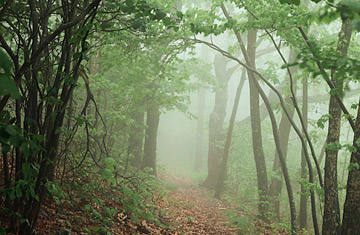
Hardwood trees along the eastern seaboard are growing rapidly.
Basic biology suggests that plants might grow faster in a world with more carbon dioxide, and field experiments bear that out: when you pump extra CO2 into a field or a forest, trees and other vegetation tend to get bigger.
There are plenty of caveats attached: without other nutrients, the size and health of CO2-enriched plants can be compromised, and in some cases noxious weeds like poison ivy do better than the greenery you might prefer. But perhaps the biggest question of all is how closely such artificial situations translate in the real world.
That question is a long way from being answered, but a study published recently in the Proceedings of the National Academy of Sciences takes a small step in that direction. A team of researchers used 22 years' worth of carefully accumulated measurements of hardwood forests in and near the Smithsonian Environmental Research Center, in Edgewater, Md., to show that their growth has accelerated significantly. On average, the stands were expanding at a rate of two extra tons of mass per acre per year, by the end of the study — the equivalent of a single two-foot-diameter tree, if you could grow a tree that big in a year. "We don't know exactly when it started," says co-author Geoffrey Parker, a forest ecologist at the Smithsonian. But the scientists do have an idea of the reason — or rather, three possible reasons, all of which are likely to be interrelated.
The first is a 12% increase in atmospheric carbon dioxide since the study began — the same CO2 increase implicated in global warming. The second is the warming itself. And the third is an increase in the growing season, defined as the length of time between the last frost in spring and the first frost in fall, which is also a consequence of warming. "We couldn't narrow it down further than that," says Parker.
What made the study possible in the first place was the fact that pretty much none of the forest in this part of the U.S. is virgin; it's been cleared for agriculture at various times, and then allowed to regrow in patches. The result: individual stands of similar trees ranging from about 225 years old to just five. "You could do this experiment by measuring a single stand of trees as long as possible," says Parker, "but a scientific career lasts only a few percent of the life of a tree." This way, he explains, you have a snapshot of the same forest at different ages."
Forest biologists already know that, all things being equal, trees grow more rapidly when they're young, then taper off as they mature, and that you can chart the standard curve of growth for a given forest type by looking at the kind of snapshots Parker and his colleagues used. It takes only a couple of years of measurements to figure out the overall growth curve. This study has been going on for 22 years, conducted largely by technicians and volunteers trained by the Smithsonian scientists. "We have a huge corps of volunteers," says Parker. "It's not rocket science but you need to do a lot of measurements and repeat them often."
Over that 22-year span, Parker and the others noticed that the growth curve gradually bends upward, meaning the regrowth was accelerating — a hint, anyway, that controlled experiments involving enriched CO2 levels were indeed a reasonable if rough proxy of what would likely happen in the real world as CO2 levels mount. Whether the forests' growth spurt might actually impact global warming by absorbing and storing more carbon is doubtful. While it's true that more trees suck up more carbon, they also produce more dark, heat-absorbing foliage, which somewhat counteracts the benefit. In addition, one extra tree per acre per year doesn't make much of a dent in the atmospheric carbon load, not to mention that it's still unknown what the effect would be in other kinds of forests.
The Smithsonian experiment will continue to see what happens next in terms of forest growth, says Parker. His suspicion: because the trees aren't getting a boost in nutrients to match the extra CO2 and warmer climate, "it probably can't go on much too much longer."
Lemonick is the senior science writer at Climate Central.
